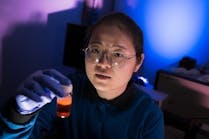The U.S. Department Energy (DOE) has selected GE Vernova’s Advanced Research business (GE Vernova) located in Niskayuna, New York, to lead a two-year, $3.3 million pre-feasibility study to establish a direct air capture (DAC) regional hub near Houston, Texas.
GE will enter award negotiations, part of the first round of funding announced from the President’s Bipartisan Infrastructure Law-funded Regional DAC Hubs program, with the DOE to finalize the terms and the scope of the study.
Researchers will study the feasibility of a novel DAC system design incorporating GE Hitachi’s BWRX-300 small modular reactor (SMR) and renewable electricity to capture CO2 from ambient air and store it underground or utilize it as a feedstock for sustainable aviation fuels (SAF).
Once completed, the project has the ability to remove 1 million tons of CO2 from the air per year, equivalent to the annual emissions from about 200,000 typical cars receiving 22 miles per gallon of gas.
“Our pre-feasibility study proposes to draw upon our full suite of energy generation assets and capabilities in ways only GE Vernova can, including carbon-free nuclear and renewable electricity, to create what we believe will be a cost-effective solution for removing millions of tons of CO2 from the atmosphere,” said Matt Guyette, Director, Advanced Research at GE Vernova.
The company is also a DAC technology provider for two other projects selected for award negotiations, which will be led by the Board of Trustees of the University of Illinois and executed in Colorado and Florida. The projects aim to promote technologies that capture CO2 from the atmosphere and store it underground in the Tuscaloosa Group in Florida and in the Denver-Julesburg Basin in Colorado.
While both studies focus on developing cooperative relationships between DAC technology providers, green energy providers, CO2 transportation networks, and companies seeking to store CO2 underground, stakeholders in the proposed DAC regional hub projects will promote community communication and engagement to establish comprehensive community benefit plans for their projects.
GE successfully demonstrated a scalable prototype direct air capture system at its Niskayuna research facility in March. The DOE’s decision will help GE Vernova to deploy a commercially scalable DAC solution by the end of 2030.
Projects support the Biden Administration’s target of removing between 400 million and 1.8 billion metric tons of CO2 from the atmosphere and emissions sources annually by 2050.





